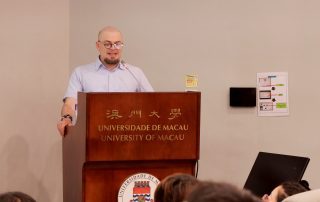【IAS】Guest Lecture “Regenerative Medicine for Sale: The Governance of Private DTC RM Therapies” was Successfully Held
【高研院】嘉賓講座"Regenerative Medicine for Sale: The Governance of Private DTC RM Therapies"成功舉行

| The IAS promotional video has been launched! We cordially invite you to watch and help spread the word! | ||
|
English |
|
中文 |
 On the occasion of the fifth anniversary of the Institute for Advanced Studies in Humanities and Social Sciences at the University of Macau, we would like to express our gratitude for your unwavering support to us. Your involvement and support have helped build a strong foundation for our interdisciplinary research platform and inspired us to keep moving forward. The IAS is excited to carry on our mission, rooted in Macau, by organizing high-quality academic activities that showcase the diversity of academic collaboration. On the occasion of the fifth anniversary of the Institute for Advanced Studies in Humanities and Social Sciences at the University of Macau, we would like to express our gratitude for your unwavering support to us. Your involvement and support have helped build a strong foundation for our interdisciplinary research platform and inspired us to keep moving forward. The IAS is excited to carry on our mission, rooted in Macau, by organizing high-quality academic activities that showcase the diversity of academic collaboration. |
||
6月16日,澳門大學人文社科高等研究院(高研院)成功舉辦主題為“Regenerative Medicine for Sale: The Governance of Private DTC RM Therapies”的嘉賓講座。此次講座邀請了麥基爾大學的Yann Joly教授主講,並由澳門大學中華醫藥研究院胡元佳教授擔任與談人,以及法學院副教授杜立教授擔任主持人。
Yann Joly教授在講座中深入探討了受商業利益驅動的直接面向消費者(DTC)再生醫學(RM)療法領域快速發展的現狀。他講這一現象追溯至三個不同的歷史階段。第一波浪潮被稱為「幹細胞旅遊」,即患者前往監管相對寬鬆的司法管轄區獲取未經證實的幹細胞干預措施;第二波浪潮則標誌著幹細胞療法的主流化擴張,全球如澳大利亞、加拿大、德國、日本等26國家,利用監管模糊性提供類似療法。當前第三波浪潮呈現再生醫學市場多元化趨勢,涵蓋外泌體療法、幹細胞儲存、CAR-T細胞治療及富血小板血漿(PRP)等新型療法,進一步加速商業化進程。
Joly教授深入剖析了再生醫學直接消費市場的最新動態,特別指出富血小板血漿療法(PRP)市場規模的顯著擴張。當前PRP市場規模已至少達到2018年幹細胞市場總規模的5.3倍,這種急速擴張凸顯了行業監管的迫切性。該趨勢標誌著再生醫學商業化的第三波浪潮已進入高速發展階段。在治理目標方面,Joly教授提出雙軌並行的核心策略:首先需建立具有技術適應性的靈活立法體系,使監管框架能夠及時響應再生醫學領域的技術迭代;同時必須強化監督執行機制與違規制裁力度,這兩大要素將直接決定治理體系的成敗。Joly在最後重申了平衡技術創新與風險管控的核心理念。面對再生醫學直接消費市場的野蠻生長,亟需通過動態化監管框架填補法律真空,在保障醫療安全與消費者權益的前提下,引導行業走向可持續發展道路。
在討論環節中,胡元佳教授與杜立教授以這三波浪潮的演進和中國與加拿大之間監管路徑差異展開對比分析。兩位學者強調,面對再生醫學領域持續擴張的商業化版圖與技術迭代,各國亟需在創新發展與風險防控間建立動態平衡機制——既要通過靈活監管框架釋放科技潛能,亦須構建跨國協同的治理網絡,方能引領產業在安全軌道上實現可持續突破。
講座重點探討了多層次法律干預框架的構建路徑,涵蓋聯邦層面的醫療產品監管與反壟斷法、省級消費者保護機制、醫務人員執業責任認定以及醫學倫理規範。特別提出行業自律機制可作為補充性治理手段,並強調東亞國家如日本和韓國的創新監管模式值得借鑒。這些法律工具需協同作用,才能有效應對當前市場亂象。現場討論氣氛熱烈,參與者圍繞治理可能性深入探討,為完善治理框架提供了豐富的啟發與建議。
On June 16, the Institute of Advanced Studies in Humanities and Social Sciences (IAS) at the University of Macau successfully hosted a guest lecture entitled “Regenerative Medicine for Sale: The Governance of Private DTC RM Therapies”. The lecture featured Professor Yann Joly from McGill University as speaker, with Professor Yuanjia Hu from UM’s Institute of Chinese Medical Sciences serving as discussant, and Professor Li Du from the Faculty of Law acting as moderator.
Professor Joly thoroughly examined the rapidly evolving landscape of commercially driven Direct-to-Consumer (DTC) Regenerative Medicine (RM) therapies in his lecture. He traced this phenomenon through three distinct historical phases: The First Wave, termed “stem cell tourism”, involved patients traveling to loosely regulated jurisdictions to access unproven stem cell interventions. The Second Wave marked the mainstream expansion of stem cell therapies, with private clinics exploiting regulatory ambiguities in 26 countries (including Australia, Canada, Germany and Japan). The current Third Wave is characterized by RM market diversification, encompassing novel therapies like Evosome therapies, stem cell banking, CAR-T cell treatments, and platelet-rich plasma (PRP), further accelerating commercialization.
Professor Joly provided an in-depth analysis of the latest developments in the direct-to-consumer regenerative medicine market, particularly highlighting the remarkable expansion of the Platelet-Rich Plasma (PRP) therapy market. The current PRP market has reached at least 5.3 times the size of the total stem cell market in 2018, a rapid growth that underscores the urgency for industry regulation. This trend signifies that the third wave of regenerative medicine commercialization has now entered an advanced stage of accelerated development.
Regarding governance objectives, Professor Joly proposed a dual-track core strategy: First, establishing a technologically adaptive legislative system to enable regulatory frameworks to promptly respond to iterations in regenerative medicine. Concurrently, enhancing monitoring enforcement, and sanctions for violations is imperative—both elements being critical determinants of governance efficacy. Joly reiterated the fundamental principle of balancing technological innovation with risk control. Confronting the unregulated expansion of the direct-to-consumer regenerative medicine market, dynamic regulatory frameworks must urgently fill legal voids to guide the industry toward sustainable development while safeguarding medical safety and consumer rights.
The lecture focused on developing a multi-tiered legal intervention framework that includes federal-level regulation of healthcare products and competition law, provincial consumer protection mechanisms, determinations of professional liability for medical practitioners, and medical ethical standards. It specifically highlighted industry self-regulation as a complementary governance tool, while underscoring the value of referencing innovative regulatory models from East Asian jurisdictions such as Japan and South Korea. The discussion was highly engaging, with participants delving deeply into the possibilities of governance, providing valuable insights and recommendations for improving the regulatory framework.




